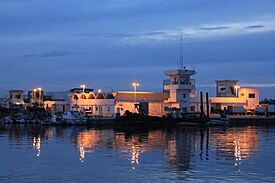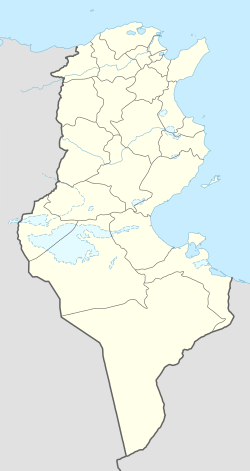Gabès facts for kids
Quick facts for kids
Gabès
قابس
|
|
|---|---|

View of Gabès bay
|
|
| Country | |
| Governorate | Gabès Governorate |
| Delegation(s) | Gabes Medina, Gabes West, Gabes South |
| Population | |
| • Total | 167,863 |
| Time zone | UTC+1 (CET) |
| • Summer (DST) | UTC+2 (CEST) |
| Website | Official website: http://www.commune-gabes.gov.tn/ar/ |
Gabès is a major city in Tunisia, a country in North Africa. It is the capital of the Gabès Governorate. The city is located right on the coast, next to the Gulf of Gabès.
With about 167,863 people, Gabès is the 6th largest city in Tunisia. It is about 327 kilometers (203 miles) from Tunis, the capital city, and 113 kilometers (70 miles) from Sfax.
Contents
History
Gabès has a very long and interesting history. It has been known by different names over time.
How Gabès Got Its Name
The old name for Gabès was Takapes. This name came from the Punic and Numidian languages, which were spoken by ancient people in this region. The word "Ta" meant "the." Over time, the "Ta" was dropped, and the city became known as Kapes. Since the Arabic language does not have the "p" sound, Kapes changed to Kabes, and then finally to Gabès.
Gabès in Roman Times
During the time of the Roman Empire, Gabès was called Tacapae or Tacapes. It was an important trading center, especially for goods coming from the nearby sea. Ancient writers like Pliny the Elder noted that the city had a clever system for sharing water from a large spring among farmers.
Major Events in Gabès' History
Gabès has seen many changes throughout its history:
- 7th Century: The city became part of the Umayyad Caliphate. A companion of the Prophet Muhammed, Sidi Abu Lubaba Al'Ansari, settled in Gabès.
- 1148: The Zirids attacked and damaged Gabès.
- 1574: Gabès became part of the Ottoman Empire after the Ottomans took control.
- 1881: France took control of Gabès, making it a French protectorate.
- 1940: During World War II, Gabès came under German control after France fell.
- 1943: British forces helped return Gabès to French control during the Battle of the Mareth Line. This battle caused a lot of damage to the city.
- 1945: The city began to be rebuilt after the war.
- 1956: Tunisia gained independence from France, and Gabès became part of independent Tunisia.
Education
Gabès is home to the University of Gabès. This university is known for its science and engineering programs. It offers some of the best chemistry degrees in Africa.
Economy
Gabès is one of the largest industrial cities in Tunisia. Many of its industries are focused on chemical products. The main types of industries in Gabès include:
- Cement factories
- Chemical product factories
- Brick factories
- Oil refineries
Because of the many factories, there has been some pollution in the area, especially in the Gulf of Gabès. However, the government has been working on new plans and laws to reduce pollution in recent years.
Transport
Gabès has good transport links, making it easy to travel to and from the city.
Air Travel
The city has its own airport, the Gabès – Matmata International Airport.
Railways
Gabès is the end point of a narrow-gauge railway line that connects it to the capital city. It is also the closest railway station to the border with Libya. Gabès also has one of Tunisia's largest ports, which is often used to ship mineral products from the city of Gafsa.
Roads
Soon, Gabès will be connected to the national motorway A1, which runs from Tunis to Ras Ajdir. This will make road travel even easier.
Climate
Gabès has a hot, dry climate, similar to a desert climate. Summers are very hot, and winters are mild and pleasant. There is not much rain throughout the year, and almost no rain during the hot summer months.
| Climate data for Gabès (1991–2020, extremes 1950–2021) | |||||||||||||
|---|---|---|---|---|---|---|---|---|---|---|---|---|---|
| Month | Jan | Feb | Mar | Apr | May | Jun | Jul | Aug | Sep | Oct | Nov | Dec | Year |
| Record high °C (°F) | 29.3 (84.7) |
33.9 (93.0) |
41.0 (105.8) |
38.2 (100.8) |
43.6 (110.5) |
46.5 (115.7) |
49.1 (120.4) |
46.6 (115.9) |
44.2 (111.6) |
40.1 (104.2) |
35.0 (95.0) |
31.2 (88.2) |
46.7 (116.1) |
| Mean daily maximum °C (°F) | 17.1 (62.8) |
18.2 (64.8) |
20.2 (68.4) |
22.6 (72.7) |
25.6 (78.1) |
28.4 (83.1) |
31.4 (88.5) |
32.5 (90.5) |
30.5 (86.9) |
27.5 (81.5) |
22.8 (73.0) |
18.3 (64.9) |
24.6 (76.3) |
| Daily mean °C (°F) | 12.6 (54.7) |
13.4 (56.1) |
15.8 (60.4) |
18.5 (65.3) |
21.9 (71.4) |
25.1 (77.2) |
27.8 (82.0) |
28.8 (83.8) |
26.8 (80.2) |
23.3 (73.9) |
18.2 (64.8) |
13.9 (57.0) |
20.5 (68.9) |
| Mean daily minimum °C (°F) | 8.1 (46.6) |
8.6 (47.5) |
11.5 (52.7) |
14.5 (58.1) |
18.3 (64.9) |
21.8 (71.2) |
24.2 (75.6) |
25.1 (77.2) |
23.2 (73.8) |
19.1 (66.4) |
13.6 (56.5) |
9.4 (48.9) |
16.5 (61.6) |
| Record low °C (°F) | −2.7 (27.1) |
−2.0 (28.4) |
0.9 (33.6) |
4.6 (40.3) |
8.2 (46.8) |
12.0 (53.6) |
15.6 (60.1) |
16.8 (62.2) |
14.4 (57.9) |
6.8 (44.2) |
2.6 (36.7) |
0.0 (32.0) |
−2.7 (27.1) |
| Average precipitation mm (inches) | 24.4 (0.96) |
12.0 (0.47) |
17.1 (0.67) |
16.8 (0.66) |
10.4 (0.41) |
1.9 (0.07) |
0.5 (0.02) |
3.1 (0.12) |
30.1 (1.19) |
30.7 (1.21) |
18.7 (0.74) |
23.9 (0.94) |
189.5 (7.46) |
| Average precipitation days (≥ 1.0 mm) | 2.9 | 2.3 | 2.0 | 2.0 | 1.5 | 0.5 | 0.0 | 0.3 | 2.1 | 3.0 | 2.1 | 2.5 | 21.2 |
| Average relative humidity (%) | 62 | 59 | 62 | 63 | 65 | 66 | 63 | 65 | 66 | 64 | 62 | 64 | 63 |
| Mean monthly sunshine hours | 214.1 | 226.8 | 251.9 | 274.1 | 308.4 | 322.2 | 354.0 | 335.1 | 259.4 | 247.8 | 218.1 | 211.1 | 3,223 |
| Mean daily sunshine hours | 7.1 | 7.7 | 8.1 | 8.9 | 10.1 | 10.7 | 12.0 | 11.4 | 9.3 | 8.4 | 7.6 | 6.8 | 9.0 |
| Source 1: Institut National de la Météorologie (humidity 1961–1990, sun 1981-2010) | |||||||||||||
| Source 2: NOAA (humidity and daily sun 1961–1990) | |||||||||||||
Tourism
Gabès is a unique place to visit because it has mountains, the sea, an oasis, and a desert all in one area!
Things to See and Do
- Traditional Souks: These are local markets in Jarah where you can find many interesting things.
- The Kornich: This is a lovely seaside promenade.
- Mosque of Sidi Boulbaba: A historic mosque.
- The Mouradi School: An old school with interesting architecture.
- Zaouia Sidi Ahmed Toujani: A religious building.
Gabès is also known for its beautiful beaches, especially the Lemawa or Lemaya beach in the south. The government plans to develop this area for tourism. During the month of Ramadan, the streets of Gabès become very lively at night, with shops open and parties happening. The nearby town of Matmata is also a popular place to visit.
World Heritage Status
The unique oasis of Gabès was added to the UNESCO World Heritage Tentative List in 2008. This means it is being considered for official World Heritage status, recognizing its special cultural importance.
Notable People
Many important people were born in Gabès:
- Gladys Adda (1921): An activist.
- Juliette Bessis (1925–2017): A Tunisian historian.
- Silvan Shalom: An Israeli politician and former minister.
- Tahar Haddad (1899–1935): A writer, feminist, and reformer.
- Mohamed Ali El Hammi (1890–1928): One of the founders of Tunisian trade unions and an activist.
Images for kids
See also
 In Spanish: Gabes para niños
In Spanish: Gabes para niños








